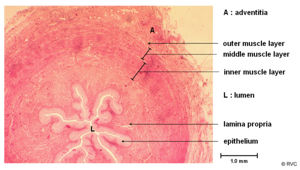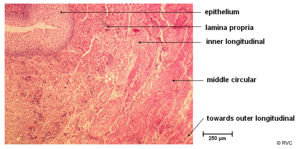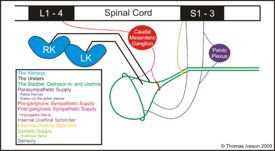Equine Urinary System - Horse Anatomy
| This article is still under construction. |
Kidneys
The kidneys of the horse are both enclosed in a fat capsule. Dorsally they rest against the psoas muscle and against the diaphragm. The left kidney is bean-shaped and the right kidney is heart-shaped. The right kidney lies cranial to the left kidney.
The right kidney is to be found ventrally to, and between, the last 2 ribs and first lumbar transverse process. Cranially it touches the liver and caudally it is attached to the pancreas and the base of caecum. The duodenum winds around its lateral and then ventral surfaces. Medially is the caudal vena cava and adrenal gland.
The left kidney is between the last rib and 3rd transverse process. Its ventral surface is almost completely covered by the peritoneum and contacts the small intestine and and small colon. The spleen contacts it cranioventrally. Medially is the left adrenal glandand aorta.
The Basic Components of the Kidney
Outer fibrous capsule
A tough outer capsule surrounds the parenchyma and this prevents the kidney expanding.
Renal Cortex
The renal cortex is comprised of two parts: the external zone and internal zone (juxtomedullar).
Renal Medulla
The renal medulla contains medullary pyramids. The part nearest the cortex is the base of the pyramid which narrows to form the inner part; the renal papilla. The medulla can be split into two parts, the outer and the inner. Different parts of the nephron reside in these areas
Outer Medulla
The outer medulla can be further divided into the outer and inner stripe
- Outer Stripe: This section located just inside the cortex contains the following parts of the nephron:
- The Inner Stripe: Located inside of the outer stripe this section contains the following parts:
The outer stripe contains the straight proximal tubules and the inner does not. However the inner contains thin ascending limbs and the outer does not. This difference makes up the anatomical demarcation between the two stripes.
Inner Medulla
The inner medulla only contains the following parts:
Renal Pelvis
The renal sinus is located within an indentation on the medial side of the kidney. The renal pelvis is located within the renal sinus. All papillary ducts open into the renal pelvis. The renal pelvis then drains into the ureters. The renal pelvis is lined with transitional epithelium and contains mucous glands in the horse; giving urine a frothy appearence.
Innervation
The kidney receives sympathetic and parasympathetic fibres from the solar plexus. These fibres travel with renal arteries. Sympathetic fibres synapse in coeliac ganglion and cranial mesenteric ganglion.
Lymphatic Drainage
- Renal lymph nodes
Ureters
The ureters convey urine from the renal pelvis to the bladder. There are two of them, one for each kidney. The ureters run retroperitoneally along the roof of the abdominal cavity and then enters the pelvis. Once entering the pelvis it moves medially in the broad ligament of the female or the genital fold of the male. It ends at its junction on the dorsolateral surface of the bladder within the lateral ligament.
Wall
The wall of the ureters has an internal mucosa layer formed from transitional epithelium. This provides protection against the urine. The middle layer is a muscularis layer. This is well developed for peristalsis, though can enter into spasm on irritation. The outer layer is composed of adventitia.
Junction with the Bladder
The ureter enters the bladder obliquely near the neck of the bladder and runs between the muscular layers and mucosa. They open through 2 slits on a raised hillock.
Movement of Urine
The movement of urine along the ureters is achieved by peristalsis which is powered by locally regulated smooth muscle. This maintains a low pressure in the renal pelvis.
Vascular Supply
The renal pelvis and proximal ureter is supplied by the renal artery. The distal ureter is supplied by the cranial vesicular artery and the vaginal artery (in the female) and prostatic artery (in the male).
Lymphatic Drainage
- Lumbar lymph nodes
Bladder
The bladder is where urine is stored before being expelled by the body through the micturition reflex. Without a bladder urinary continence would be impossible.
The bladder is a hollow, muscular organ. It is divided for descriptive purposes into three parts:
- Cranial Pole
- Intermediate body
- Caudal neck
Its wall comprises a muscle layer covered in transitional epithelium. Its size and posistion are determined by how full it is. When empty the bladder wall is wrinkled and thicker. It rests on the pubic bones, entirely within the pelvis and is largely retroperitoneal. When full and distended, the folds disappear and the wall appears thinner, it then becomes intraperitoneal.
The trigone of the bladder gets its name as it looks like a triangle without a base. It is of clinical importance and is formed by the paired ureteric folds, which are comprised of the orifice of the ureters. The trigone is visible even when the bladder is full. Ureteral folds extend from the urethral opening to the neck of the bladder, where they merge to form the urethral crest. It is believed to have increased sensitivty and is of different embryological origin to the rest of tissue. More details can be found here.
Muscles of the Bladder
The three muscular components of the bladder described below play a pivotal part in the micturition reflex.
Detrusor Muscle
This network of smooth muscle fibres lie in three sheets within the bladder wall and are supplied by both parasympathetic and sympathetic nerves. It is responsible for storage and expression of urine from the bladder.
- Parasympathetic supply: This comes from S1-S3, synapses within the pelvic plexus, continues as the pelvic nerves and is excitatory to the destrusor muscle. Parasympathetic dominance allows emptying of the bladder.
- Sympathetic Supply: This comes from L1-L4, synapses within the caudal mesenteric ganglion in the bladder wall, continues as the hypogastric nerve and ends on beta 2 receptors within the detrusor muscle. It has inhibitory action on muscular contraction, therefore enabling bladder filling.


